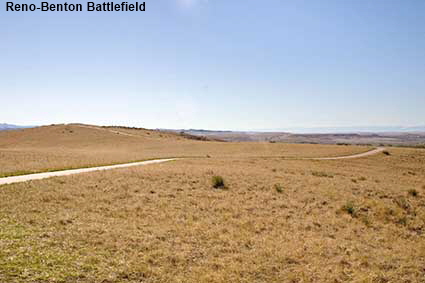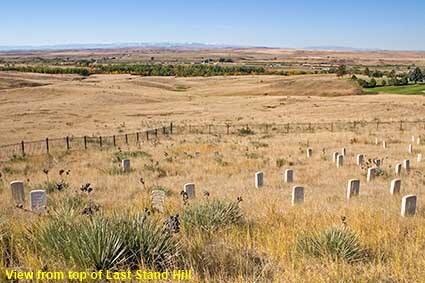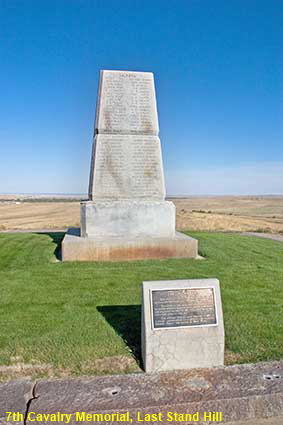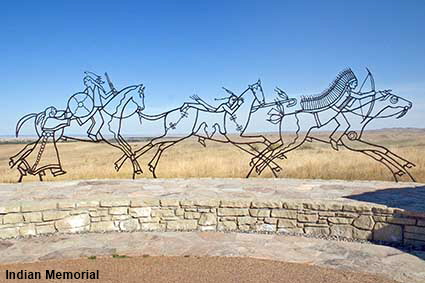Little Bighorn Battlefield
Americans do not take kindly to any re-evaluation of their historical heroes. Take the example of Davy Crockett - when a movie tried to depict the historical fact that he survived the Alamo and was executed later there was a huge outcry and the ending had to be changed to align with the myth that he died in a hail of bullets during the battle. Lt. Colonel George Custer seems to be an exception to this rule. He used to be portrayed as a hero who lost his life taking a stand against Indian savages. Now it has been realised that the Indians were doing no more than trying to protect their lifestyle in the face of a US government that didn’t just move the goalposts, it kept rewriting the ‘rules’. So now the Battle of the Little Bighorn is seen as a clash of cultures, and it is acceptable to question whether Custer’s tactics were appropriate.
7th Cavalry Memorial, Last Stand Hill,
Custer with around 225 men circled round the Indian Encampment to attack from the north. With no survivors amongst Custer’s men, details of their route are uncertain, but Indian accounts say that some of his soldiers approached the eastern bank of the river opposite the Encampment. Indian warriors crossed the river to attack them, making the soldiers retreat to Calhoun Hill to the north. Pursuing warriors soon overran the hill, forcing the soldiers to move north along the ridge. After several bloody skirmishes, Custer with 41 remaining men found themselves on Last Stand Hill, encircled by Indian warriors. Custer ordered his men to shoot their horses and stack the carcasses to form a wall, but they provided little protection. In less than an hour, Custer and all of his men were killed. Custer is buried at West Point and the officers were also buried in eastern cemeteries, but the soldiers who died are buried in this mass grave on Last Stand Hill. Click Tab 2 to see a picture of the marker showing where Custer fell.
View from top of Last Stand Hill
The battlefield is in two parts, the Custer Battlefield and the Reno-Benton Battlefield about 5 kilometres (3 miles) to the south east. There were around 7,000 Lakota, Cheyenne and Arapaho Indians camped on the western bank of the Little Bighorn River on June 25, 1876 in defiance of Government orders that restricted them to reservations. The 600 strong US 7th Cavalry commanded by Lt. Colonel George Armstrong Custer was approaching from the south. Custer had been ordered to await reinforcements, but decided to press ahead. He divided his forces into three, with Major Reno’s battalion sent to attack the southern end of the encampment and a group commanded by Captain Benteen sent to cut off escape routes.
Indian Memorial
The Battle of the Little Bighorn counts as one of America’s worst military disasters but afterwards it was the Indians who lost out. Custer was a civil war hero, and no one was going to ask questions about his tactics or about the Government’s treatment of Indians. The harsh crackdown that followed the battle saw the lifestyle that the Indians were trying to defend all but eliminated. In 1999 the National Park Service redressed the balance with an Indian Memorial and markers showing where warriors fell. Click Tab 2 to see a picture of the marker showing where warrior Little Whirlwind fell.
Reno-Benton Battlefield
Reno soon found his battalion of 175 men outnumbered in fierce battle. They were forced to retreat with the loss of around 40 men. They regrouped on this hill where they were eventually joined by Benteen’s group. Here they managed to make a stand here until the Indians withdrew the following day when they learned that two columns of US soldiers were approaching to relieve the remnants of the 7th Cavalry.
Click on Minimap to navigate
DLU061122






To move forwards or backwards through the Montana trail click the arrows above, or select your next destination on the Minimap.


© Mike Elsden 1981 - 2025
The contents of this page may not be reproduced in full or in part without permission